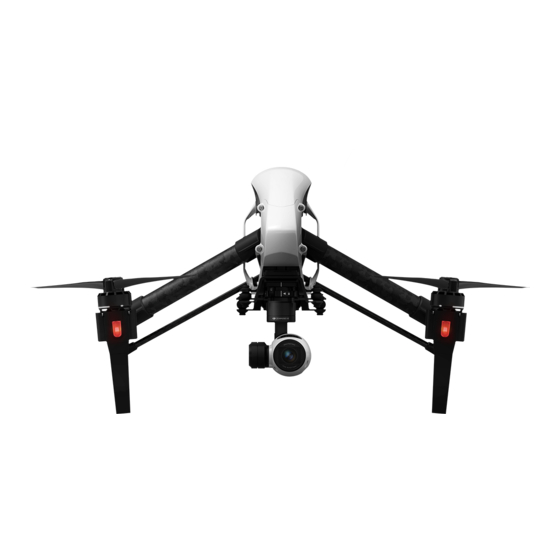dji Inspire 1 Краткое руководство по эксплуатации - Страница 4
Просмотреть онлайн или скачать pdf Краткое руководство по эксплуатации для Квадрокоптеры dji Inspire 1. dji Inspire 1 11 страниц.
Также для dji Inspire 1: Краткое руководство по эксплуатации (10 страниц), Руководство пользователя (20 страниц)

Fly Safe
Calibrating the Compass
●
Make sure to calibrate the compass in every new flight location. The compass is very sensitive to electromagnetic interference,
which can cause abnormal compass data leading to poor flight performance or even failure. Regular calibration is required for
optimum performance. Recalibrate the compass when: a) The Aircraft Status Indicator is blinking red and yellow. b) Flying in a
new location.
DO NOT calibrate your compass where there is a chance of strong magnetic interference, such as magnetite, parking
●
structures, and steel reinforcements underground.
DO NOT carry ferromagnetic materials with you during calibration such as keys or cellular phones.
●
DO NOT calibrate beside massive metal objects.
●
If the Flight Status LED is showing solid red, then try to calibrate again. If it is blinking red and yellow alternately after placing
●
the aircraft on the ground, the compass has detected magnetic interference. Change your location.
P Mode:
●
Safe to fly. In this mode, the Inspire 1 has a strong GPS signal and
can use the Vision Positioning System allowing it to hover accurately
in position indoors and out. If outdoors, this mode also means that a
Home Point has been locked so that it can Return to Home if the
control signal is lost.
If you are not in this mode, toggle the Flight
Mode Switch to P position to enable it.
The Flight Mode Switch is locked in P mode by default.
Refer to the User Manual on how to unlock the switch.
There are three states in P mode.
P-GPS: GPS works best when outdoors in a wide open area, and
your Inspire 1 uses GPS to hover in place when the GPS signal is
strong. P-OPTI: If GPS is not available, the aircraft can use the
Vision Positioning System to hover accurately. P-ATTI: Neither
GPS or Vision Positioning System available, aircraft is using only
its barometer for positioning, so only altitude is controlled.
Note that the Vision Positioning System may not work properly when
the Inspire 1 is flying over water, over surfaces without a clear pattern,
or in a low light environment.
While returning home, its altitude can be adjusted by the user to avoid obstructions. Tall buildings may affect the remote controller signal.
●
The Failsafe Return to Home procedure will be triggered if the signal is lost. Be sure fly higher than any nearby buildings to avoid crashing.
Flight Limits:
●
The Inspire 1 is not permitted to fly within no-fly zones as specified
by local laws and regulations. Please visit here:
http://www.dji.com/fly-safe
Environmental Considerations:
●
1. Do not fly in severe weather conditions. This includes high wind, snow, rain and smog.
2. Only fly in open areas. Tall buildings and steel structures may affect the accuracy of the onboard compass and GPS signal.
3. Avoid from obstacles, crowds, high voltage power lines, trees or bodies of water.
4. Minimize electromagnetic interference by not flying in areas with high levels of electromagnetism, including mobile
phone base stations or radio transmission towers.
5. Aircraft and battery performance is subject to environmental factors such as air density and temperature. Be very careful when
flying 14700 feet (4500 meters) or more above sea level as battery and aircraft performance may be reduced.
6. The Inspire 1 cannot operate in P mode or use GPS at polar latitudes. It only can fly in ATTI mode and use the Vision Position-
ing System.
Return to Home:
●
When the GPS signal is strong, the aircraft will be able to record a
Home Point and return to the Home Point when needed. The GPS
location is recorded when the GPS signal icon in the DJI Pilot app is
either yellow or green.
Return to home
The aircraft will return to the Home Point automatically in the following
cases (all require a strong GPS signal).
Smart RTH: When you press the RTH button on the remote controller
or in the App. Low Battery RTH: The DJI Pilot app notifies users to take
action when the battery level falls to a specified threshold.
Failsafe RTH: When the remote controller signal is lost.
for more information.
GPS Positioning
Vision Positioning
Altitude 2.5 m
